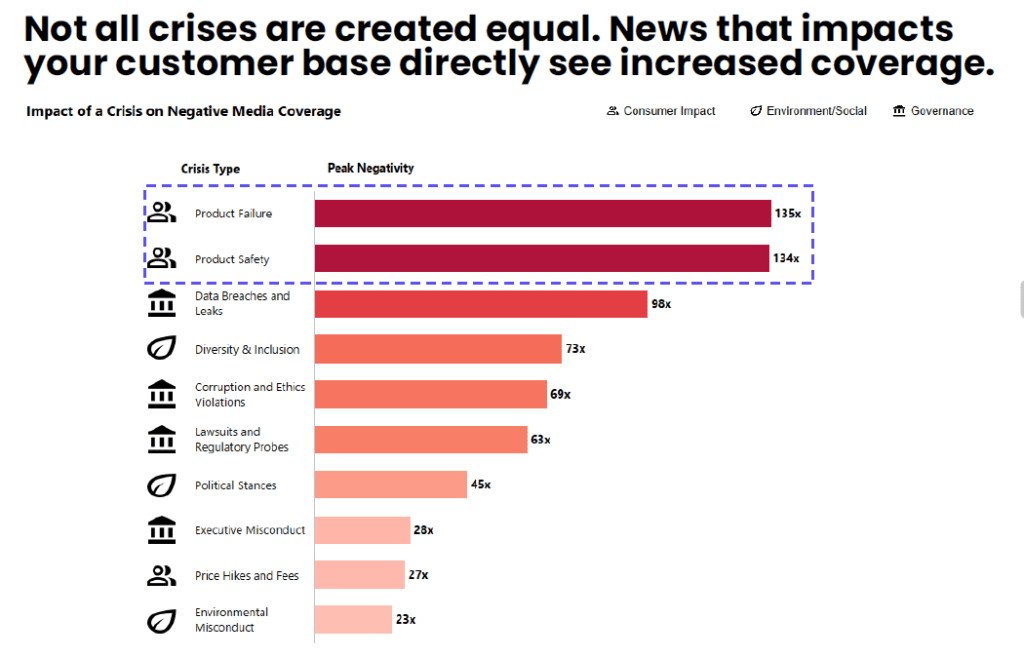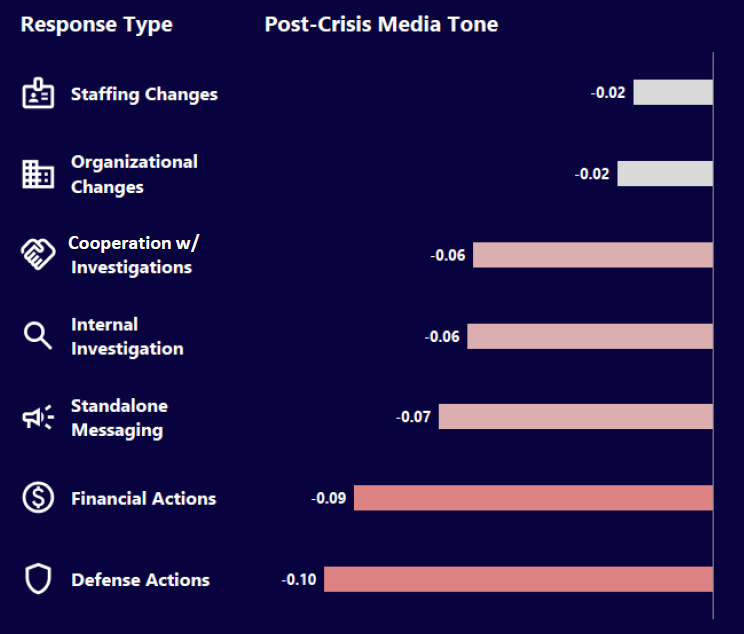The Impact of a Consumer Impact Crisis
When a consumer impact crisis hits, the ripple effects can be both immediate and long-lasting. These crises—triggered by product failures, safety concerns, or sudden price hikes—directly affect customers’ experiences and drive a surge in media coverage. In fact, PublicRelay’s Benchmark data shows that consumer impact crises generate 135 times more negative media stories compared to a typical day. High-profile incidents like prolonged service outages or massive product recalls often dominate headlines, amplifying reputational risks.

Some examples include:
- The Quaker Oats incident of 2024, where over 60 products were recalled due to salmonella risk, resulting in the shutdown of their Danville, IL manufacturing facility due to ongoing unsanitary conditions.
- Multiple safety issues with Boeing planes that led to a hearing in front of the Senate Commerce Committee and fears of boarding a Boeing-built aircraft.
- The deadly Boar’s Head listeria outbreak resulting from unimaginable conditions at their now-closed Virginia facility, which killed 10 people and has recently ended with a $3.1M settlement as part of a class-action lawsuit.
These can be extremely harmful to your company’s reputation, so how do you strategically navigate a consumer impact PR crisis if you find yourself in this situation? It is important to remember that regardless of your response, there’s likely to be some sort of penalty to long-term media reputation.
The following actions can help mitigate that:
1. Take Direct Action Immediately
Consumers are quick to pass judgment on brands that appear slow to act. The first hours of a crisis are critical. Swift, decisive action can make a significant difference in shaping public perception. If products need recalling, act without hesitation. Expand customer support options to handle the surge in inquiries. Taking these steps shows commitment to minimizing negative effects for your customers, which can soften the immediate blow to your brand’s reputation.
2. Emphasize Transparency
Rebuilding trust starts with open communication. Acknowledge the issue promptly and explain why it happened. PublicRelay’s data highlights that media coverage is notably more critical of brands that provide vague or evasive responses. When you deliver clear, honest information, you take control of the narrative and begin the process of restoring public confidence.
3. Sympathize with Your Customer Base
Effective crisis communication is just as much about empathy as it is facts. Consumers want to feel heard and understood, especially if the crisis directly affects their experience. An example of what not to do here is Peloton’s response after their Tread+ treadmill led to dozens of injuries and the death of a child. Andrew Moyer, a crisis management expert, describes it well: “Peloton failed to appreciate—and should have predicted—the strong emotional reaction of many when they heard ‘urgent warning’, ‘death’, and ‘children’ in the same sentence”, and instead issued a “tone deaf statement pushing back against the federal safety regulator’s warning to consumers.”
Craft messaging that acknowledges customer concerns and outlines how you’re addressing the issue. Whenever possible, have a spokesperson deliver this message to humanize your response and build a bridge back to your audience. Peloton generally bounced back after bringing their CEO, John Foley, into the conversation, who admitted to their poor initial response.
4. Avoid Hand-Waving Concerns
Consumer impact issues demand more than just a financial settlement or vague assurances. PublicRelay’s data indicates that companies that respond defensively or merely pay fines without addressing customer concerns see far worse long-term reputational damage. To truly recover, your brand needs to demonstrate accountability and commitment to making things right. You can’t just pay to make the problem go away.

Conclusion
A consumer impact PR crisis is a defining moment for your brand. With the right strategy—immediate action, transparent communication, empathetic messaging, and genuine accountability—you can navigate the storm and emerge stronger. But the wrong approach risks alienating your customers for the long haul.
By leveraging real-time media intelligence and understanding the nuances of consumer-driven narratives, your communications team can craft responses that not only mitigate damage but also rebuild trust for the future.
Learn more about how PublicRelay’s Benchmark insights can guide your crisis response. Connect with us to see how data-driven strategies can enhance your media strategy.